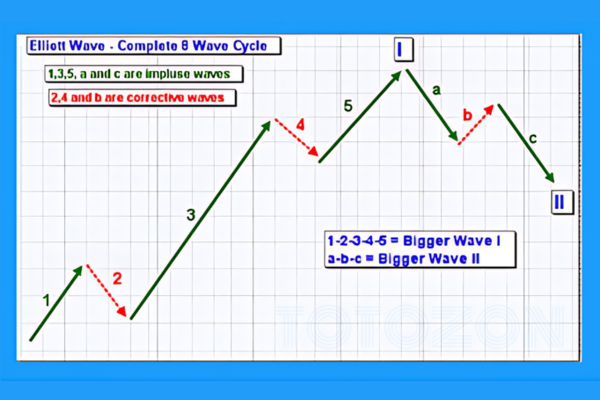Module 4 Elliot Wave and Identify Wave Count
$399.00 Original price was: $399.00.$31.00Current price is: $31.00.
File Size: Coming soon!
Delivery Time: 1–12 hours
Media Type: Online Course
CryptosClass – Module 4: Elliott Wave and Identify Wave Count
Introduction
Navigating the turbulent waters of cryptocurrency trading can be daunting. Enter Elliott Wave Theory, a robust tool designed to decode market trends. Module 4 of CryptosClass delves deep into this theory, providing traders with the skills to identify and leverage wave counts effectively.
What is Elliott Wave Theory?
Elliott Wave Theory, formulated by Ralph Nelson Elliott, posits that market prices move in predictable patterns or “waves.” These waves reflect the collective psychology of market participants and can be analyzed to forecast future price movements.
Core Principles of Elliott Wave Theory
- Wave Patterns
- Impulse Waves: Move in the direction of the trend
- Corrective Waves: Move against the trend
- Wave Structure
- Five-Wave Sequence: Three impulse waves (1, 3, 5) and two corrective waves (2, 4)
- Fractals
- Smaller waves form the same patterns as larger waves, creating a fractal structure
Importance of Identifying Wave Count
Accurate wave counting is essential for applying Elliott Wave Theory. It involves labeling the waves within a price movement to predict future trends.
Steps to Identify Wave Count
- Identify the Starting Point
- Find the beginning of the wave sequence
- Label the Impulse Waves
- Mark the five waves moving in the trend direction
- Label the Corrective Waves
- Identify the three waves moving against the trend
- Validate the Wave Count
- Ensure the wave count follows Elliott Wave rules and guidelines
Applying Elliott Wave Theory in Crypto Trading
Understanding and applying Elliott Wave Theory can significantly enhance your cryptocurrency trading strategy.
Step-by-Step Application
- Analyze Historical Data
- Review historical price charts to identify wave patterns
- Determine Current Wave Position
- Assess where the current price is within the wave sequence
- Forecast Future Movements
- Use the wave count to predict upcoming price movements
- Make Informed Decisions
- Apply your wave analysis to execute strategic trades
Common Challenges in Wave Counting
Wave counting can be complex, but understanding these challenges can help you overcome them.
Challenges
- Subjectivity
- Wave counting can vary between analysts
- Complex Patterns
- Market movements can be intricate, making wave identification difficult
- Frequent Adjustments
- Wave counts may need adjustments as new data emerges
Tips for Overcoming Challenges
- Practice Regularly
- Consistent practice with historical data improves accuracy
- Use Multiple Timeframes
- Analyze wave patterns across different timeframes
- Stay Informed
- Keep updated with market trends and news
Tools for Elliott Wave Analysis
Several tools can aid in Elliott Wave analysis, enhancing your accuracy and efficiency.
Elliott Wave Software
- Elliott Wave International
- Provides advanced tools for wave analysis
- TradingView
- Offers charting tools and Elliott Wave indicators
Manual Charting
- Paper and Pencil
- Traditional method for practicing wave counts
- Digital Tools
- Use digital drawing tools for marking wave patterns on charts
Integrating Elliott Wave with Other Strategies
Combining Elliott Wave Theory with other trading strategies can improve its effectiveness.
Technical Analysis
- Indicators
- Utilize RSI, MACD, and moving averages to confirm wave counts
- Chart Patterns
- Integrate head and shoulders, double tops, and other patterns with wave analysis
Fundamental Analysis
- Economic Indicators
- Consider economic data and news events to support wave analysis
- Market Sentiment
- Analyze sentiment to validate wave counts and predictions
Case Study: Applying Elliott Wave in a Bull Market
Let’s explore a real-world example to illustrate the application of Elliott Wave Theory in a bullish cryptocurrency market.
Identifying Impulse Waves
- Wave 1: Initial uptrend driven by positive market sentiment
- Wave 2: Minor correction as traders take profits
- Wave 3: Strong uptrend fueled by significant news or developments
- Wave 4: Brief pullback due to market consolidation
- Wave 5: Final surge as optimism peaks
Identifying Corrective Waves
- Wave A: Initial decline as early adopters exit positions
- Wave B: Temporary rebound due to renewed optimism
- Wave C: Continued decline as the market corrects further
Conclusion
Elliott Wave Theory offers a powerful framework for understanding and predicting market movements in cryptocurrency trading. By mastering wave counting and integrating it with other analytical methods, traders can enhance their market insights and make more informed decisions.

Commonly Asked Questions:
- Business Model Innovation: Accept the truth of a legitimate business! Our strategy is organising a group buy in which participants share the costs. We use these cash to acquire popular courses from sale pages and make them available to people with limited financial resources. Despite the authors’ worries, our clients love the cost and accessibility we give.
- The Legal Environment: Yes or No The legality of our activity is ambiguous. While we don’t have specific permission from the course authors to resell the material, there is a technicality at work. The author did not specify any limits on resale when purchasing the course. This legal intricacy is both an opportunity for us and a boon for individuals looking for low-cost access.
- Quality Control: Uncovering the Truth
Getting to the heart of the issue – quality. Purchasing the course straight from the sale page guarantees that all documents and resources are the same as those obtained through traditional channels.
However, we distinguish ourselves by going beyond personal research and resale. It is crucial to note that we are not the official course providers, which means that the following premium services are not included in our package:
- There are no scheduled coaching calls or sessions with the author.
- Access to the author’s private Facebook group or web portal is not permitted.
- No access to the author’s private membership forum.
- There is no direct email support available from the author or their team.
We operate independently, with the goal of bridging the pricing gap without the extra services provided by official course channels. Your comprehension of our distinct approach is much appreciated.
Be the first to review “Module 4 Elliot Wave and Identify Wave Count” Cancel reply
You must be logged in to post a review.
Related products
Forex Trading
Forex Trading
Forex Trading
Forex Trading
Forex Trading
Forex Trading
Forex Trading
Forex Trading






















Reviews
There are no reviews yet.